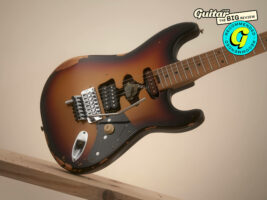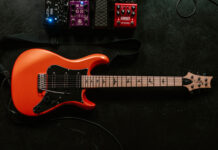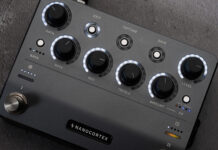
EVH Frankenstein Relic review – a slice of pure Eddie Van Halen innovation, without the stripes
$1,499/£1,269, evhgear.com
Whisper it, but there’s a genuine chance Edward Van Halen’s legacy as an innovative electric guitar and amp designer could well outlive his legacy as a game-changing and stratospheric player. That idea is not as outlandish as it might seem – it’s worth remembering that in his day, Les Paul was the world’s most famous and respected guitarist, who innovated in ways nobody had ever dreamed of before. But 70-odd years later, he’s much more famous for the guitar that bears his name than any of his trailblazing musical achievements alongside Mary Ford.
READ MORE: PRS SE NF3 review – the S-type guitar for people who want more than Mayer tones
And as much as Eddie popularised techniques in Van Halen that were subsumed by the guitar gods that followed him, his guitar and amp tinkering changed the sound of rock guitar. Just take Eddie’s most famous creation – the Frankenstein, or FrankenStrat – that guitar alone popularised the use of a humbucker in an S-type guitar, the Floyd Rose tremolo system, and jumbo fret-wire. As with Les Paul, it almost doesn’t matter whether you’re a fan of Van Halen’s music – chances are you’ve been indirectly influenced by his legacy.
Image: Adam Gasson
What is the difference between the Relic series and the Striped series?
There’s probably no more famous relic than Eddie’s Frankenstein, and it is EVH’s replica of that icon – the ‘Striped Series Frankenstein Frankie’ – that forms the basis of the more subdued EVH Relic series, sharing almost identical specs.
However, there are many guitarists who value individuality, and the prospect of sporting a signature guitar – whether its namesake is an influence or not – is a violation of their identity, so the most iconic signature guitar of all time – a red, white, and black striped beaten up bits-o-caster – is never going to be on their radar. This prompted the relic series, offering the same guitar but in several ‘standard’ finishes, including this sunburst relic.
Image: Adam Gasson
What on earth is going on with the electrics and why is the neck so worn-looking?
Eddie had little in the way of finesse when it came to modifying guitars. His approach was very much function over form, which is why the Frankenstrat replicas have a crudely chiselled-out bridge pickup cavity, redundant neck pickup, and dormant pickup selector in the middle pickup cavity. Yes, you read correctly, the neck pickup here purposely does not work – which should be of little surprise given there’s no functioning pickup selector!
King Edward knew how to create a neck carve that’s for sure. I remember many years ago a friend passing me a Peavey Wolfgang – a signature model he first created with the US compant back in 1996. I still have an abiding memory of how perfect that neck carve felt – slim with a comfy set of shoulders. The Relic’s neck is not too dissimilar in terms of dimensions, and the worn-in aspect – including ground-in grime – offers an enhanced level of comfortability and playability. As a fan of chunkier necks, it takes a special kind of slim neck to turn my head, and this is certainly one of them. It’s an absolute joy to play and its rounded shoulders mean your thumb isn’t grabbing mostly fresh air when reaching over the top, and the 12-16” compound radius allows me to set the action pretty darn low, with zero threat of fretting out being detected.
Image: Adam Gasson
Is the Floyd Rose easy to use?
Based on experience, it’s my view that if you’re a guitarist over 40 who doesn’t use the whammy bar extensively, then setting up a floating Floyd Rose is not the best use of your dwindling years on this planet. It’s a time-consuming and miserable affair. Thankfully, the EVH Floyd Rose is not floating, but instead set up to move downwards only, eliminating much of the tediousness of ensuring it’s parallel with the body. Another advantage is the fact you can make use of EVH’s patented D-Tuna here. It allows you to drop the low E-string to D at the touch of a button (sort of).
Image: Adam Gasson
Does the EVH Frankenstein Relic live up to its name?
If there was ever such a thing as a plug-in-and-play guitar, then this is it, for there’s no pickup selector, and no tone control – just plug in the jack and away you go!
The tone I’m met with is chock full of personality as its appearance, and the EVH Wolfgang bridge humbucker is tonally reminiscent of a Seymour Duncan JB, with its accentuated mids and medium-high output. Through my Diezel VH4 patch, a bouncy, punchy and reactive rock tone shines through with each strum of an open chord, producing a rich tone as wide as the grin on my face!
I was expecting a slightly more even tone considering the basswood body but high frequencies are all present and correct minus the hi-end shrill that an alder-bodied S-type sometimes provides in this format. This is a quintessential rock tone and it’s impossible to think of how it could be improved. Clarity – check, punchiness when palm muting – check, searing lead tone – check. It’s all here.
With the bridge humbucker being the only pickup in operation, you’d be forgiven for thinking it’s a bit of a one-trick pony. However, anyone familiar with EVH’s playing – or many of the greats for that matter – will know that judicious manipulation of the volume control will yield many different tones, and rolling it off here shaves a little of the high frequencies but not as much as I’d expect. On a hi-gain setting with the volume rolled off a little, I find an eminently desirable mid-gain rock rhythm sound, and further rolling off gets us nicely into clean-ish territory.
Half the fun of the limited electronics is finding these sweet spots, and some of the greatest tones you’ve heard will no doubt be the result of the volume slightly rolled off.
Image: Adam Gasson
Should you buy the EVH Frankenstein Relic?
Eddie was once quoted as saying, “Anyone who says that they’re not making music for people can kiss my ass. Why bother making records and trying to sell them if you’re trying to make music for yourself”. Unintentionally perhaps, this philosophy has applied to the amps and guitars he’s helped design over the years, though in this instance he was arguably making instruments and amps to suit his needs. It just so happens that his needs would be desirous of millions of us.
This could be the fork in the road where EVH becomes a brand in itself, and not one inextricably linked to its inspirer. The relic series is certainly a declaration of this intention and the recent Wolfgang Van Halen signature SA-126 pushes that idea even further.
The aesthetic here could prove divisive but in equal measure, its over-the-top quirkiness will prove appealing. However, if you strip back the fun element of the guitar, it seriously lays claim to being one of the best-sounding rock guitars in this price range. It plays as great as the artist who inspired it and continues the legacy of an icon who designed some of the most influential guitar equipment I’ve ever used. Long live the king.
EVH Relic Frankenstein alternatives
A guitar brand at the forefront of the 80s Superstrat movement was Charvel, and its limited edition relic’d Pro-Mod So-Cal Style M Henrik Danhage ($1,699/£1,349) created in collaboration with the Evergrey guitarist is similar and spec and vibe the EVH series. Schecter produces its own range of 80s-inspired super shredders and the Schecter Sun Valley Super Shredder FR ($749/£789) is well worth checking out, as is the Jackson X Series Signature Adrian Smith SDX ($599/£449) which is the cheaper alternative and an aggressive S-type in its own right.
The post EVH Frankenstein Relic review – a slice of pure Eddie Van Halen innovation, without the stripes appeared first on Guitar.com | All Things Guitar.
Source: www.guitar-bass.net












